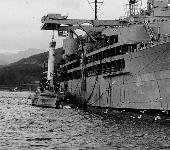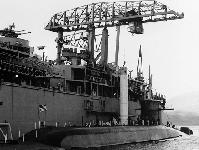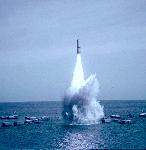









The Polaris A1 weighed 28,800 lb, with a length 28.5 ft and diameter 54 in., it had a range of approximately 1000 nm. The first stage (18,400 lb) had a steel motor case; polyurethane propellant (15,200 lb) with ammonium percholorate (oxidizer) and aluminum additives. The second stage (9,400 lb) also used a steel motor case; polyurethane propellant (7,300 lb) with ammonium perchlorate (oxidizer) and aluminum additives.
The first major development problem in the A1X flight test program manifested itself in A1X-2, the second stage of which failed in the vicinity of No. 5 thrust termination port, due to overheating. It was an insulation and bonding problem, and was a continuation of the type of trouble experienced in earlier flight tests. This failure generated an extensive investigation of head end insulation and bonding. The head end fix with a continuous boot and potting solved one problem but introduced another, since later flights experienced thrust termination port failures; they did not open up and arrest the forward movement of the second stage, which continued on and bumped the reentry vehicle. The continuous boot was probably a major contributor to the anomaly. The solution to the new problem included scoring the boot around the periphery of each thrust termination port.
The launch of a Lockheed-built Polaris A1 Fleet Ballistic Missile was the first in history from a submerged submarine, the USS George Washington (SSBN 598). It occurred July 20, 1960, off Cape Canaveral, Florida, and within three hours a second Polaris test missile was launched. On November 15, 1960, the submarine and its 16 Polaris A1s began the first patrol.
On 2 June 1964, the USS George Washington (SSBN-598). returned to Charleston, South Carolina, to off-load missiles in preparation for overhaul at General Dynamics, Electric Boat Division, shipyard in Groton, Connecticut. This ended the initial deployment of the first FBM submarine, with POLARIS A1's which began in November 1960. Finally on 14 October 1965, the USS Abraham Lincoln (SSBN-602) returned to the U.S., completing her initial deployment. She was the last of the first five SSBNs carrying the POLARIS A1 to return to the U.S. for overhaul. This marked the official retirement of the POLARIS A1 missile from active fleet duty. These first five boats were being refitted to carry POLARIS A3 missiles.
Specifications |
|
